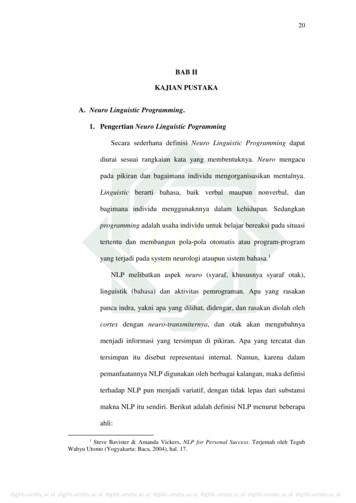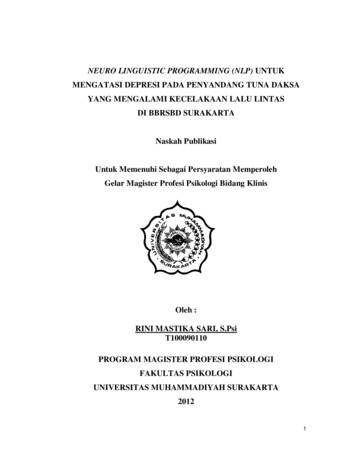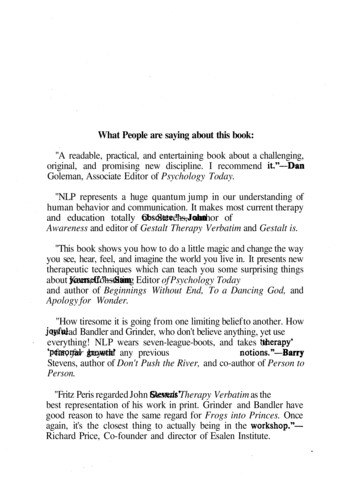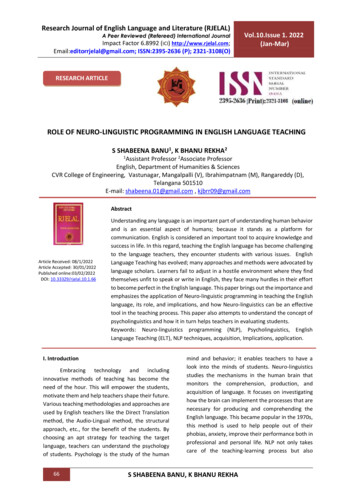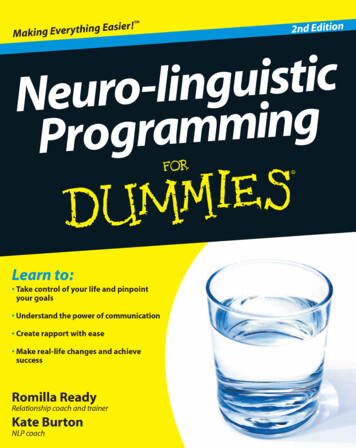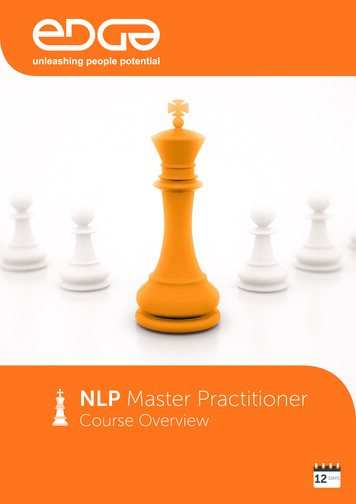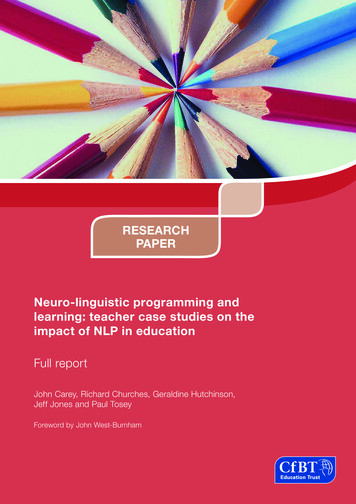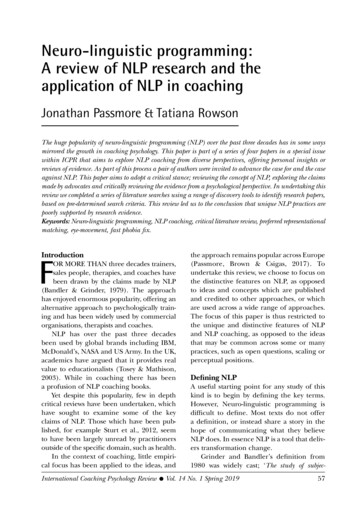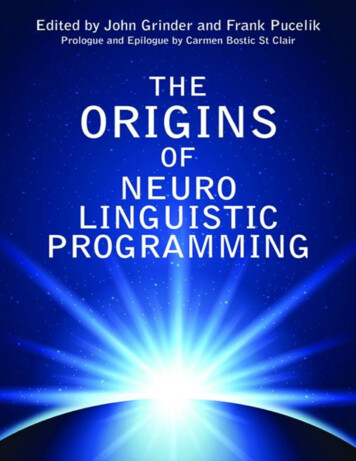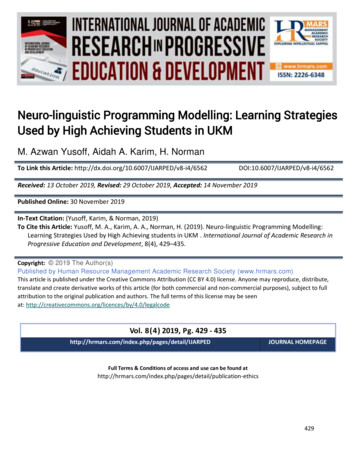
Transcription
International Journal of Academic Research in Progressive Education andDevelopmentVol. 8 , No. 4, 2019, E-ISSN: 2 2 2 6 -6348 2019 HRMARSNeuro-linguistic Programming Modelling: Learning StrategiesUsed by High Achieving Students in UKMM. Azwan Yusoff, Aidah A. Karim, H. NormanTo Link this Article: .6007/IJARPED/v8-i4/6562Received: 13 October 2019, Revised: 29 October 2019, Accepted: 14 November 2019Published Online: 30 November 2019In-Text Citation: (Yusoff, Karim, & Norman, 2019)To Cite this Article: Yusoff, M. A., Karim, A. A., Norman, H. (2019). Neuro-linguistic Programming Modelling:Learning Strategies Used by High Achieving students in UKM . International Journal of Academic Research inProgressive Education and Development, 8(4), 429–435.Copyright: 2019 The Author(s)Published by Human Resource Management Academic Research Society (www.hrmars.com)This article is published under the Creative Commons Attribution (CC BY 4.0) license. Anyone may reproduce, distribute,translate and create derivative works of this article (for both commercial and non-commercial purposes), subject to fullattribution to the original publication and authors. The full terms of this license may be seenat: deVol. 8(4) 2019, Pg. 429 - DJOURNAL HOMEPAGEFull Terms & Conditions of access and use can be found tion-ethics429
International Journal of Academic Research in Progressive Education andDevelopmentVol. 8 , No. 4, 2019, E-ISSN: 2 2 2 6 -6348 2019 HRMARSNeuro-linguistic Programming Modelling: LearningStrategies Used by High Achieving Students in UKMM. Azwan Yusoff, Aidah A. Karim, H. NormanFaculty of Education, Universiti Kebangsaan Malaysia, UKM Bangi, Selangor, MalaysiaEmail: azwanukm@Yahoo.Com, eda@ukm.edu.my, helmi.norman@ukm.edu.myAbstractMost higher education students are unfamiliar with effective learning strategies that preventedthem from achieving good academic result. The purpose of this research is to explore learningstrategies of high achieving students. This study employed a qualitative methodology andinvolved four high achieving students and used semi-structured interviews. This study found tenlearning strategies and thirty-seven learning tactics employed by high achieving students. Thisstudy found that learning strategies and tactics found in the study suit neuro-linguistic modellingapproach. The study suggested that students must be exposed to neuro-linguistic modellingapproach early in their university live.Keywords. Learning Strategies, High Achiever, Neuro-linguistic Programming, and Modelling.IntroductionUnder-achieving students in higher education often do not understand and apply effectivelearning approaches, which prevented them from achieving good academic result. Muelas andNavarro (2015) stated that low academic achievement was due to weak and ineffective learningstrategies. The role of learning styles and students’ performance were also highlighted by otherstudies such as Razak, Zulkifli and Noh (2018); Jaki, Ambun and Yunus (2018); Ishak and Awang(2018); Ph’ng, Ming and Nambiar (2016); Abdullah, Daud, Ariff, & Shaifuddin, (2018) and Thanget al. (2015). From the past research conducting by Stott and Hobden (2015), they had furtheridentified three learning strategies namely interrogating information, thinking it through, andorganizing and linking. They interviewed gifted high achieving student from the rural area schoolthat focused in science learning. There is a gap in this study that should we consider, we decidedto conduct the interview with university’s high achieving students in learning strategiesperspective. Learning strategies are a special kind of procedural knowledge and knowing how todo something (Woolfolk 2016). Despite an increased interest to excel in academic but very fewstudies focused on developing framework for effective learning strategies in higher learning usingNeuro-Linguistic Programming or NLP. Therefore, this study aimed to identify effective learningstrategies among high achieved university students in the Malaysian context and further mappedthose strategies with NLP approach.430
International Journal of Academic Research in Progressive Education andDevelopmentVol. 8 , No. 4, 2019, E-ISSN: 2 2 2 6 -6348 2019 HRMARSLiterature ReviewBodenhamer and Hall (1999) explains that Neuro-linguistic Programming or NLP is divided intothree main components: neuro (N), linguistic (L) and programming (P). Neuro refers to our mindand how it processes information and codes it as memory. Linguistic means that, throughlanguage and communication structures, neural processes of the mind come coded, organizedand given significance. Programming refers to our ability to organize these parts (sights, sounds,feelings, smells, tastes) in our mind-body organism so that we can produce our desired results.Using NLP theory, researchers performs NLP modeling techniques on outstanding students whichto explore and elicit their learning strategies. Researchers can more clearly identify the factors ofexcellence and reflection in their minds during learning activities or actions to be taken (Bandler& Grinder 1975; Kudliskis 2013; Iyem, Ozturk, Yildiz, 2018).“NLP studies brilliance and quality, bringing outstanding results to individuals and organizations.The techniques can be demonstrated to others so that they can also achieve the same results.This is called modeling.“(O’connor, 2001). “The NLP's primary approach was the modeling ofefficient behaviors and cognitive processes. The NLP modeling method includes the analysis oflinguistic patterns and non-verbal communication in the way that the brain operates. The resultsof this analysis are then used step-by-step strategies or programs to transfer the skills into otherindividuals and application fields”(Dilts 1998). From the past NLP research, NLP modellingtechniques that will establish positive effects and improve the performance of athletes in thekinesthetic domain by stimulating visual and auditory channels (Grosu et al. 2014). NLP modellingtechniques was used which involving learning modalities such as visual, auditory, kinesthetic(“saw,” “heard,” “felt”) (Dilts 1998; Grosu et al. 2014). NLP modelling techniques comes up withquestions like how does it look, sound and feel as well as how students learn in specific ways andthe secret that the students do every day in their life.MethodologyA qualitative methodology has been used for this research. This research explored narratives oflearning strategies produced by four high achieving students in one public university in Malaysia.The high achievers from this research context was students that won the Royal Education Awardat the university convocation ceremony. This award is the highest achievement awarded by theuniversity to students who excelled in academic, leadership, exemplary character andcommitment to the society. The students must obtain at least a Pass with Honors (withdistinction) with a final CGPA of 3.7 in the final semester. The students came from Islamic Studies,Social Science & Humanities, Economy and Management, and Medicine.There are two types of instruments used in this study, the interview protocol and documentanalysis. For data collection, we prepared semi structured interviews questions based on learningstrategies literature. In addition, documents that we used was online and offline material suchas articles related and YouTube interviews conducted by UKM. Bogdan and Bilken (2003) statedthat data are rarely validated with one method, but several validation techniques. Data obtainedfrom one source may not be sufficient for this study, so researchers use the triangulation method.The diversity of these sources of knowledge can make this study rich in diverse sources of431
International Journal of Academic Research in Progressive Education andDevelopmentVol. 8 , No. 4, 2019, E-ISSN: 2 2 2 6 -6348 2019 HRMARSinsights. Triangulate various sources of information by analyzing evidence from sources to createa coherent explanation of the issues. Another validity strategy that we use was member checking.Member checking is to determine the accuracy of the qualitative findings by taking specificthemes back to high achievers and determining whether the high achievers believe that they arecorrect (Creswell & Creswell, 2018). Narratives of learning strategies by high achievers wererecorded and transcribed. Transcript was analyzed using thematic analysis which generatinginitial codes and naming themes were most challenging and complicated tasks (Braun & Clarke,2006).ResultThe result showed ten learning strategies that used by high achieving students. The learningstrategies are visualization, goals, attitude, emotional intelligence, information technology, timemanagement, learning practices, note, memorize and examination. Besides, we identified thirtyseven of associated tactics that characterized high achievers. All ten learning strategies and thirtyseven tactics can be seen in the table 2 below.Table 1. Ten learning strategies that used by high 3. Attitude4. EmotionalIntelligence5. InformationTechnologyTacticsa. learningb. idolc. motivational wordsa. the purpose of the studyb. the goal of socializationc. career goala. consciousb. opportunisticc. confidentd. hard worke. fastf. spirituala. identify your emotionsb. control your emotionsc. recognize the emotions ofothersd. build relationshipd. motivate oneselfa. spesific websiteb. internet videoc. internet search432
International Journal of Academic Research in Progressive Education andDevelopmentVol. 8 , No. 4, 2019, E-ISSN: 2 2 2 6 -6348 2019 HRMARSd. social networks6. TimeManagementa. planning activitiesb. planning prioritiesa. learning goalsb. learning styles7. Learning Practices c. active learningd. learning in classe. learning environmenta. practice of writing notes8. Noteb. note stylec. visual notea. acronym9. Memorizeb. locic. mnemonica. before the exam10. Examinationb. during the examc. after the examDiscussionFrom the previous research, Stott and Hobden (2015) reported three learning strategies namelyinterrogating information, thinking it through, and organizing and linking. This researchcontribute ten learning strategies that influence students in learning and the students will haveas much mileage out of the learning strategies theme as they could. The advantage researchersby using NLP modeling techniques was emerging of surprising code that the code on unexpectedfindings and could not be anticipated before the research started (Creswell, & Creswell, 2018).The theme comprises surprising code are visualization, memorize and emotional intelligence.Visualization is the process of making pictures or movies in our mind (Wong 2009). Visualizationis a strong visual encoding memory instrument and can generate a powerful visual picture thatcan be retrieved from long-term memory. Information presented in visual or graphical form, suchas a picture or a diagram, is often more easy for many students especially for visual learners toapply this strategy. In this research, visualization strategy can make high achieving students feelmotivation before they study and remember what they had learned.Besides visualization strategy that makes high achievers remember what they had learned. Theyalso have strategy that called memorize, which uses visualization in specific way. Memorizestrategy comprises three tactics namely acronym, loci and mnemonic, which make theyremember long lasting than others. Through mnemonic tactic, mnemonic is a memory systemthat is a bridge for you to retrieve long-term memory information (Wong, 2009). High achievershave developed their own way of remembering something but the other doesn't understand.They also include some visual, sound and emotion in it to help them remember better.433
International Journal of Academic Research in Progressive Education andDevelopmentVol. 8 , No. 4, 2019, E-ISSN: 2 2 2 6 -6348 2019 HRMARSEmotional intelligence strategy consists five major tactics namely identify your emotions or selfawareness, control your emotions or managing emotions, recognize the emotions of others, buildrelationship and motivate yourself. Emotional intelligence (EI) was established by DanialGoleman and Goleman (1997) pointed out that intelligence quotient (IQ) contributes only 20%to the success of a lifetime and the rest 80% comes from emotional intelligence (EI). Researchershave successfully discovered emotional intelligence, same as five of Daniel Goldman’s (EI)components using NLP modeling techniques. Researchers also believe that besides highachiever’s IQ, the high archiver also had emotional intelligence to excel in academic.The future study of this research is how to disseminate this learning strategies to our studentswith better understanding that can benefit for future generation. Furthermore, modeling thehigher achiever might be to view from different perspectives for next research such as criticalthinking, problem solving, and emotional experiences.AcknowledgementThis work was supported by UKM grants PP-FPEND-2019 and GG-2019-067ReferencesAbdullah, C. Z. H., Daud, S. C., Ariff, N. Z. Z. M., & Shaifuddin, N. (2018). Bibliographic Control andResource Description Access Standard in Malaysia. International Journal of AcademicResearch in Progressive Education and Development, 7(3), 96–102Bandler, R., and Grinder, J. (1975). The Structure of Magic, Volume I : A Book About Languageand Therapy. Palo Alto CA: Science & Behavior Books.Bodenhamer, B. G, and Hall, L. M. (1999). The User’s Manual For the Brain : The Complete ManualFor Neuro-Linguistic Programming Practitioner Certification. Crown House Publishing.Bogdan, R. C., and Bilken, S. K. (2003). Qualitative Research for Education. An Introduction toTheories and Methods. 4th ed. Pearson Education Group.Braun, V., and Clarke, V. (2006). “Using Thematic Analysis in Psychology.” Qualitative Research inPsychology 3(May 2015): 77–101.Creswell, John, W., and Creswell, J. D. (2018). Research Design : Qualitative, Quantitative andMixed Methods Approaches. Sage Publications Inc.Dilts, R. (1998). Modeling with NLP. Meta Publications, Capitola,CA.Goleman, D. (1997). Emotional Intelligence : Why It Can Matter More Than IQ. Bantam Books.Grosu, Florina, E., Grosu, T., Preja, T., and Balint, B. (2014). “Neuro-Linguistic Programming Basedon the Concept of Modelling.” Procedia - Social and Behavioral Sciences 116: 3693–99.Ishak, N., & Awang, M. M. (2017). The relationship of student learning styles and achievement inhistory subject. The International Journal of Social Sciences and Humanities Invention 4(3).3372-3377Jaki, V. A., & Yunus, M. M. (2018). Language learning styles among TESL undergraduate studentsin Universiti Kebangsaan Malaysia from different gender groups. The Asian EFL Journal.20(8). 76-89Kudliskis, V. (2013). “Neuro-Linguistic Programming and Altered States : Encouraging Preparation434
International Journal of Academic Research in Progressive Education andDevelopmentVol. 8 , No. 4, 2019, E-ISSN: 2 2 2 6 -6348 2019 HRMARSfor Learning in the Classroom for Students with Special Educational Needs.” British Journalof Special Education 40(2).Ph'ng, M. L., Ming, T. S., & Nambiar, R. M. K. (2016). Match or mismatch: Teaching styles andlearning styles in an ESP classroom. The Social Sciences. 11 (12). 2977-2982Muelas, A., and Navarro, E. (2015). “Learning Strategies and Academic Achievement.” Procedia Social and Behavioral Sciences 165: 2.625.O’connor, Joseph. (2001). The NLP Workbook : The Practical Guidebook to Achieving the ResultsYou Want. Harper Collins.Razak, K. A., Zulkifli, H., & Noh, M. A. C. (2018). Jour of Adv Research in Dynamical & ControlSystems, 10 (12). 1366-1370Stott, Angela, and Hobden, P. A. (2015). “Effective Learning : A Case Study of the LearningStrategies Used by a Gifted High Achiever in Learning Science.” Gifted Child Quarterly 1(12).Thang, S. M., Nambiar, R. M. K., Wong, F. F., Jaafar, N. M. & Amir, Z. (2015). A clamour for moretechnology in universities: What does an investigation into the ICT use and learning stylesof Malaysian digital natives tell us. Asia-Pacific Edu Res. 24 (2). 353-361Wong, L. (2009). Essential Study Skills. Houghton Mifflin Company.Woolfolk, A. (2016). Educational Psychology. Pearson Education.Iyem, C., Ozturk, D. G., Yıldız, F. Z. (2018). Clustering and Clustering Potential in TR 32 RegionsProvince, International Journal of Academic Research in Accounting, Finance andManagement Sciences 8 (3): 336- 345.435
Bodenhamer and Hall (1999) explains that Neuro-linguistic Programming or NLP is divided into three main components: neuro (N), linguistic (L) and programming (P). Neuro refers to our mind and how it processes information and codes it as memory. Linguistic means that, through language and communication structures, neural processes of the mind .
